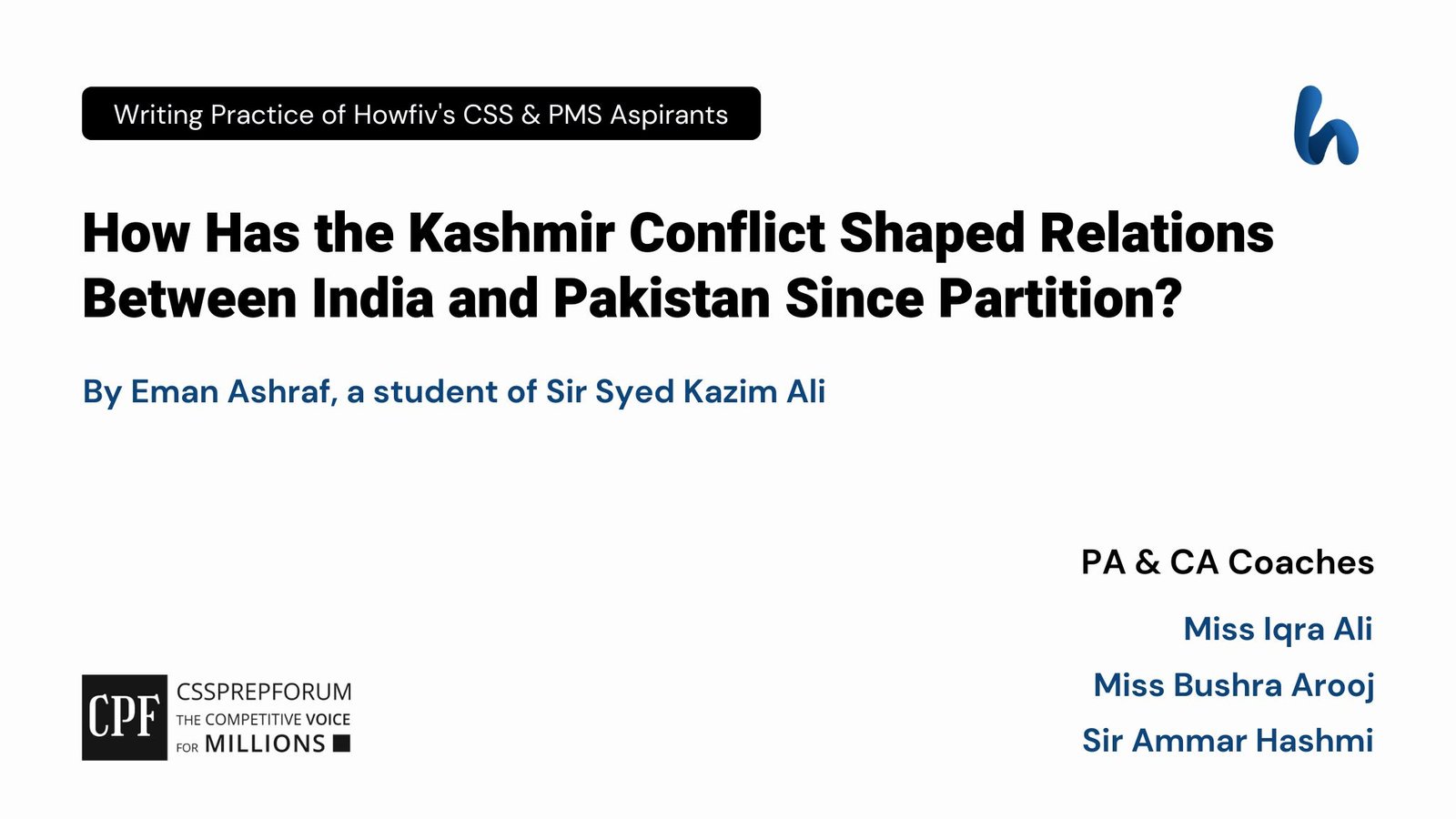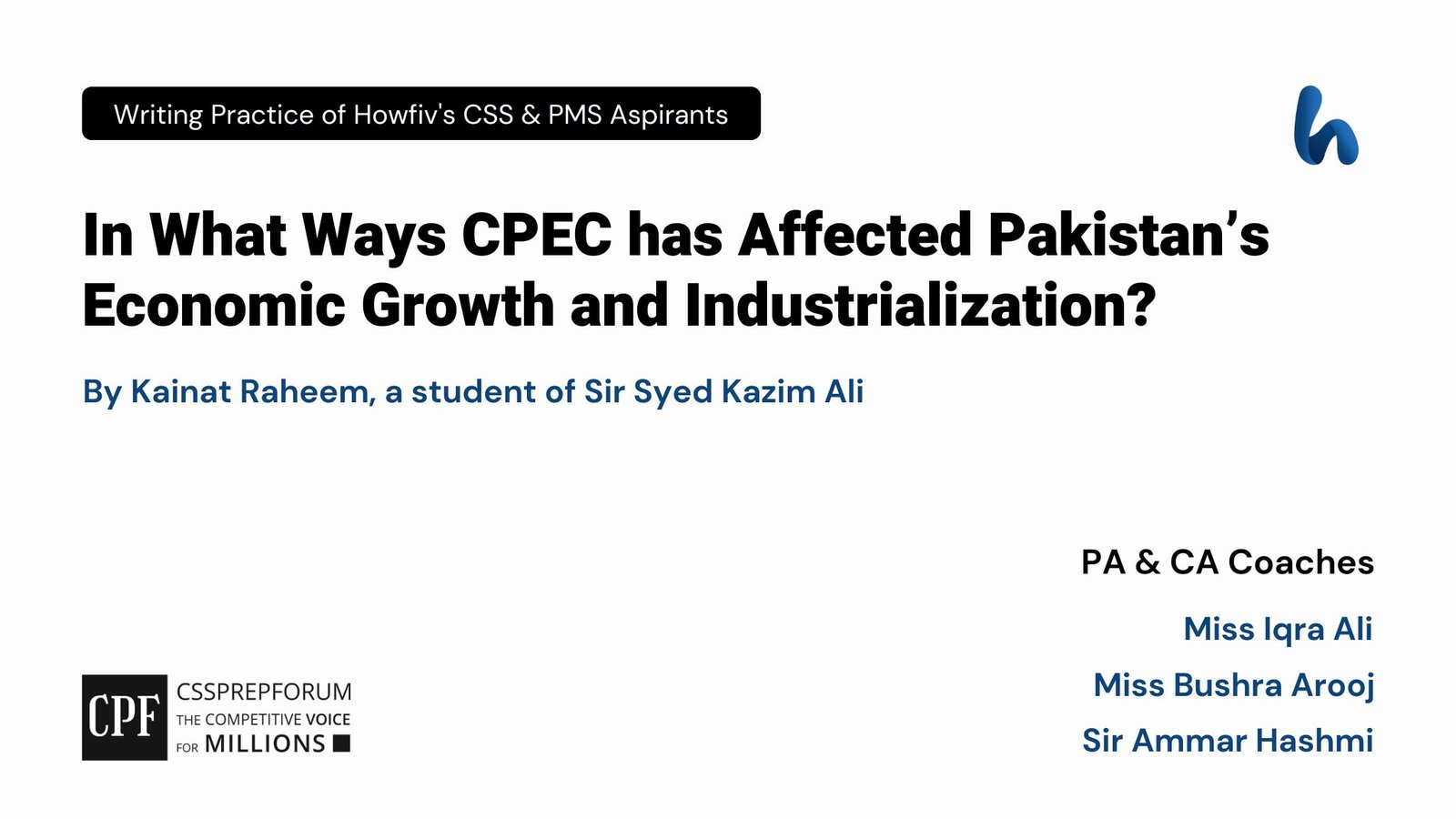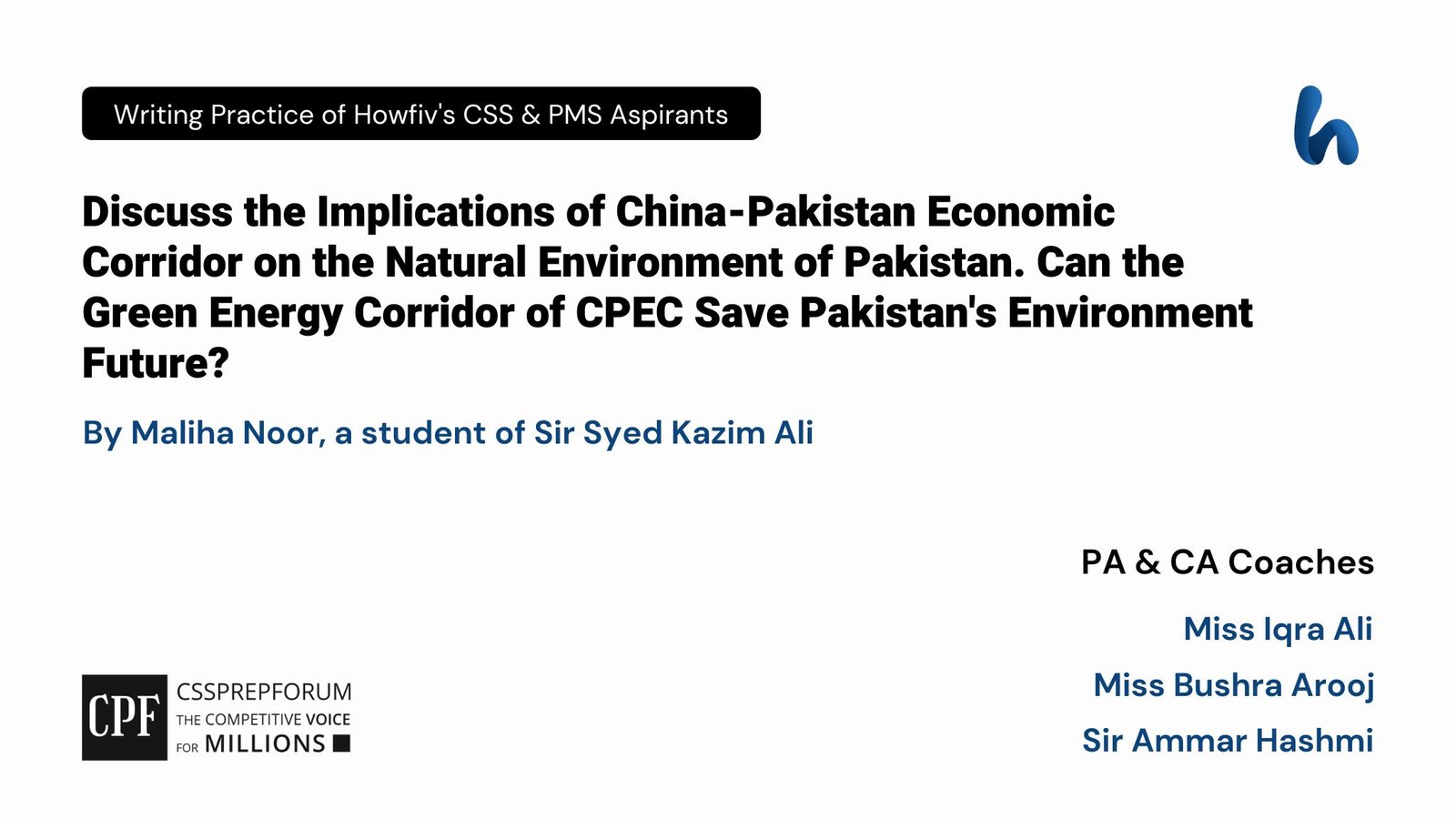CSS 2020 Solved Environmental Science Past Paper | Write the main principles of the Rio Summit?
Aqsa Tanveer, the highest scorer in the CSS Environmental Science paper, attempts the following question. The answer is written on the same pattern, taught by Sir to his students, scoring the highest marks in compulsory subjects for years. This solved past paper question is uploaded to help aspirants understand how to crack a topic or question, how to write relevantly, what coherence is, and how to include and connect ideas, opinions, and suggestions to score the maximum.

Question Breakdown
In this question, the examiner enquires about the main principles of Earth Summit. An inclusive and appropriate outline is mandatory to interpret the question better. You have to begin with an introduction and a glance at the significance of the Rio summit. Furthermore, the salient features of principles must be described to better address the question. For value addition, diagrams and flow charts can play an influential role. A satisfactory conclusion must be given at the end to summarize the whole question.
Outline
1-Introduction
2- A glance at the significance of Earth Summit 1992
3- The main principles of the Rio Summit
- ✓ Principle1: Human being centre of sustainable development
- ✓ Principle 2: State rights and responsibilities
- ✓ Principle 3: Right of development and sustainable development
- ✓Principle 4: Environment protection and development
- ✓Principle 5: Eradicate poverty for sustainable development
- ✓Principle 6: Needs of developing and environmentally vulnerable states
- ✓Principle7:Cooperation to protect the ecosystem
- ✓Principle8:Reduction of unsustainable patterns of production and consumption
- ✓ Principle9:capacity building for sustainable development
- ✓Principle10:Public participation
- ✓ Principle11:National environmental legislation
- ✓ Principle12:supportive international economic system
- ✓ Principle13: state law regarding compensation for pollution victims
- ✓ Principle14:state cooperation to prevent environmental degradation
- ✓ Principle15:precautionary principle
- ✓ Principle16: internalization of environmental costs
- ✓ Principle17:Environmental impact assessment
- ✓ Principle18: Notification of natural disasters
- ✓ Principle19: prior and timely notification
- ✓ Principle20: The vital role of women
- ✓ Principle21:Youth mobilization
- ✓ Principle22: vital role of Indigenous people
- ✓ Principle23: people under oppression
- ✓ Principle24:Warfare and destruction of sustainable development
- ✓ Principle25:Peace, development and environmental protection
- ✓ Principle26: resolve environmental disputes
- ✓ Principle27:Cooperation in good faith
5- Conclusion

Answer to the Question
Introduction
The United Nations Conference on Environment and Development (UNCED) occurred in June 1992 in Rio de Janeiro. It was a milestone in the history of international relations that placed heads of state together. Furthermore, government officials, delegates from UN agencies, officials of international organizations, and many NGO representatives were part of the summit. This summit reaffirmed the Declaration adopted at Stockholm on 16 June 1972. Therefore, it was made explicit that people can no longer consider environment and economic and social development as isolated fields. In addition, major international treaties and agreements on the global climate change, deforestation, biological diversity, and desertification concluded at the Earth Summit. The Declaration of Rio inculcates primary rules on which nations’ future decisions and policies can be based while considering the environmental implications of socio-economic development. The goal of the summit was to establish a new and equitable global partnership by creating new levels of cooperation among states, societies, and individuals. Moreover, it emphasized working towards international agreements to respect the interests of every nation and protect the integrity of the environmental and developmental system worldwide. Henceforth, Earth Summit recognized the integral and interdependent nature of the Earth.
A glance at the significance of the Rio Summit 1992
The principles of the Rio Summit 1992 define people’s right to development and their responsibilities to safeguard the standard environment. As per the Rio Declaration statement, the only way to have long-term economic progress is to link it with environmental protection. The Declaration was to be built upon the Stockholm Convention of 1972, so as the former reaffirmed the latter, more than 175 countries were signatories to it. The Rio Declaration is a collection of guiding principles that describes states’ rights and obligations in environmental protection and sustainable development. The UN produced this crucial document and guideline for upcoming generations. The Rio Declaration states that nations may use natural resources inside their boundaries as long as doing so does not impair the surroundings of other countries. There are the following outcomes of this Summit:

The main principles of the Rio Summit
Principle 1
Human beings are at the centre of concern for sustainable development and deserve a healthy and productive life in harmony with nature.
Principle 2
By the Charter of the United Nations and international law, the states have the right to exploit their resources, considering their own environmental and developmental policies. Furthermore, they do not cause damage to the environment of neighbouring states.
Principle 3
The environmental and developmental needs of present and future generations must be fulfilled.
Principle 4
Environmental protection shall constitute an integral part of the development process and cannot be considered in isolation to achieve sustainable development.
Principle 5
To eradicate poverty, all states and individuals should cooperate. Therefore, the needs of the majority of the people of the world must be met.
Principle 6
The particular situation and needs of developing countries shall be given special priority. As these are environmentally vulnerable and least developed states.
Principle 7
States shall cooperate per global partnership to protect, conserve, and restore the health and integrity of the earth’s ecosystem. States have common but differentiated responsibilities given the different contributions to environmental degradation.
Principle 8
To achieve sustainable development and a higher quality of life for all people, States should reduce and eliminate unsustainable production and consumption patterns and promote appropriate demographic policies.
Principle 9
States should cooperate to strengthen endogenous capacity-building for sustainable development by improving scientific understanding through exchanges of scientific and technological knowledge and by enhancing the development, adaptation, diffusion and transfer of technologies, including new and innovative technologies.
Principle 10
All concerned citizens’ participation at the relevant levels can best address environmental issues. Therefore, each individual shall have proper access to information regarding the environment held by public authorities at the national level. Furthermore, they should have the opportunity to participate in decision-making processes. States shall facilitate widely available information to encourage public awareness and participation.
Principle 11
States shall implement effective environmental legislation and standards on a priority basis. Standards applied by some developing countries may be inappropriate and of unwarranted economic and social cost.
Principle 12
To better address the environmental problems, states should cooperate and collaborate in the promotion of an open and supportive international economic system that would lead to economic growth and sustainable development. To deal with environmental challenges, unilateral actions should be avoided outside the state’s jurisdiction.
Principle 13
States shall develop national laws related to liability and compensation for the victims of environmental degradation. States shall also cooperate expeditiously and be more determined to create further international laws regarding liability and compensation for harmful effects of environmental damage that is caused by activities within their jurisdiction or control of areas beyond their jurisdiction.
Principle 14
States cooperate for any activity and substances that cause environmental degradation or are found to be harmful to human health to prevent relocation to other states.
Principle 15
To protect the environment, the precautionary approach shall be widely applied by States, keeping in view their capabilities. Furthermore, the lack of scientific certainty shall not be used to delay the cost-effective measures to prevent environmental degradation.
Principle 16
National authorities should strive to promote the internalization of environmental costs. Therefore, the polluter should bear the cost of pollution, with due regard to the public interest and without damaging international trade.
Principle 17
As a national instrument, an environmental impact assessment shall be undertaken for proposed activities that are likely to have a significant negative impact on the environment.
Principle 18
In a natural disaster or emergency, states shall immediately notify other States. As these events are likely to produce sudden harmful effects on the environment of other States.
Principle 19
States shall provide timely notification and relevant information to potentially affected states in good faith on activities that may have a significant adverse transboundary environmental effect.
Principle 20
Women have a vital role in environmental management and development. Therefore, their full participation is mandatory to achieve sustainable development.
Principle 21
The creativity and courage of the world’s youth should be utilized to forge a global partnership to achieve sustainable development, ensuring a better future for all.
Principle 22
Indigenous people and other local communities, because of their knowledge and traditional practices, have a crucial role in environmental management and development; states, through practical participation, should recognize and duly support their identity, culture, and interests.
Principle 23
The environment and natural resources of people under oppression, domination and occupation shall be protected.
Principle 24
Warfare is destructive to sustainable development. States shall, therefore, respect international law for protecting the environment during armed conflict and cooperate in its further development.
Principle 25
Peace, development and environmental protection are interdependent.
Principle 26
Under the charter of the United Nations, States shall resolve all their environmental disputes peacefully and by appropriate means.
Principle 27
States and people shall cooperate in good faith and spirit under the principles of the Declaration and in the further development of international law for sustainable development.
Conclusion
The Earth Summit 1992 concluded that sustainable development could be achieved while emphasizing economic, social, and environmental issues. International ecological cooperation reached a turning point. The Summit was the starting point for several later international agreements, including the Kyoto Protocol and the Paris Climate Agreement. Furthermore, the Summit also emphasized the necessity for global action to solve interconnected problems like poverty, environmental degradation, and social injustice. The Rio Earth Summit helped to further international efforts for ecological preservation and sustainable development. As a result, comprehensive programs like Agenda 21 might be adopted. To sum up, Earth Summit broadly manifested the interdependent nature of environmental, social and economic problems.
“We must honour, and the Earth must support, all its children. But, overall, this growth cannot continue. The population must be stabilized rapidly. If we do not do it, nature will, and much more brutally.”

CSS Solved Past Papers’ Essays
Looking for the last ten years of CSS and PMS Solved Essays and want to know how Sir Kazim’s students write and score the highest marks in the essays’ papers? Then, click on the CSS Solved Essays to start reading them.
CSS Solved Essays
CSS Solved General Science & Ability Past Papers
Want to read the last ten years’ General Science & Ability Solved Past Papers to learn how to attempt them and to score high? Let’s click on the link below to read them all freely. All past papers have been solved by Miss Iqra Ali & Dr Nishat Baloch, Pakistan’s top CSS GSA coach having the highest score of their students.
General Science & Ability Solved Past Papers
CSS Solved Pakistan Affairs Past Papers
Want to read CSS Pakistan Affairs Solved Past Papers and learn how to attempt them to score high? Let’s click on the link below to read them all freely. All past papers’ questions have been attempted by Sir Kazim’s students, who scored the highest in the subject.
CSS Solved Pakistan Affairs
CSS Solved International Relations’ Past Papers
Have you opted for International Relations in the CSS examination and want to score above 150? Then, click on the CSS Solved International Relations’ Past Papers by Miss Abeera Fatima, the top IR scorer and the best IR coach in Pakistan.
CSS Solved International Relations Past Papers












